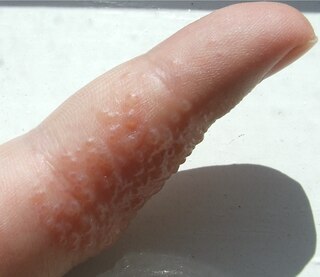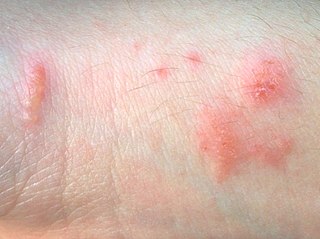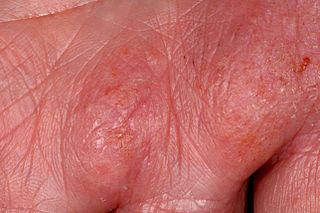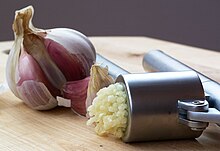
Garlic is a species of bulbous flowering plant in the genus Allium. Its close relatives include the onion, shallot, leek, chive, Welsh onion, and Chinese onion. It is native to South Asia, Central Asia and northeastern Iran and has long been used as a seasoning worldwide, with a history of several thousand years of human consumption and use. It was known to ancient Egyptians and has been used as both a food flavoring and a traditional medicine. China produces 76% of the world's supply of garlic.

Dermatitis is inflammation of the skin, typically characterized by itchiness, redness and a rash. In cases of short duration, there may be small blisters, while in long-term cases the skin may become thickened. The area of skin involved can vary from small to covering the entire body. Dermatitis is often called eczema, and the difference between those terms is not standardized.

Urushiol is an oily mixture of organic compounds with allergenic properties found in plants of the family Anacardiaceae, especially Toxicodendronspp., Comocladia spp. (maidenplums), Metopium spp. (poisonwood), and also in parts of the mango tree as well as the fruit of the cashew tree. In most individuals, urushiol causes an allergic skin rash on contact, known as urushiol-induced contact dermatitis.

Allicin is an organosulfur compound obtained from garlic, a species in the family Alliaceae. It was first isolated and studied in the laboratory by Chester J. Cavallito and John Hays Bailey in 1944. When fresh garlic is chopped or crushed, the enzyme alliinase converts alliin into allicin, which is responsible for the aroma of fresh garlic. The allicin generated is unstable and quickly changes into a series of other sulfur-containing compounds such as diallyl disulfide. Allicin is part of a defense mechanism against attacks by pests on the garlic plant.

Contact dermatitis is a type of acute or chronic inflammation of the skin caused by exposure to chemical or physical agents. Symptoms of contact dermatitis can include itchy or dry skin, a red rash, bumps, blisters, or swelling. These rashes are not contagious or life-threatening, but can be very uncomfortable.

Photodermatitis, sometimes referred to as sun poisoning or photoallergy, is a form of allergic contact dermatitis in which the allergen must be activated by light to sensitize the allergic response, and to cause a rash or other systemic effects on subsequent exposure. The second and subsequent exposures produce photoallergic skin conditions which are often eczematous. It is distinct from sunburn.

Nummular dermatitis is one of the many forms of dermatitis. it is characterized by round or oval-shaped itchy lesions. The name comes from the Latin word "nummus," which means "coin."
An occupational disease or industrial disease is any chronic ailment that occurs as a result of work or occupational activity. It is an aspect of occupational safety and health. An occupational disease is typically identified when it is shown that it is more prevalent in a given body of workers than in the general population, or in other worker populations. The first such disease to be recognised, squamous-cell carcinoma of the scrotum, was identified in chimney sweep boys by Sir Percival Pott in 1775. Occupational hazards that are of a traumatic nature are not considered to be occupational diseases.

Dyshidrosis is a type of dermatitis that is characterized by itchy blisters on the palms of the hands and bottoms of the feet. Blisters are generally one to two millimeters in size and heal over three weeks. However, they often recur. Redness is not usually present. Repeated attacks may result in fissures and skin thickening.

Urushiol-induced contact dermatitis is a type of allergic contact dermatitis caused by the oil urushiol found in various plants, most notably sumac family species of the genus Toxicodendron: poison ivy, poison oak, poison sumac, and the Chinese lacquer tree. The name is derived from the Japanese word for the sap of the Chinese lacquer tree, urushi. Other plants in the sumac family also contain urushiol, as do unrelated plants such as Ginkgo biloba.

Alliin is a sulfoxide that is a natural constituent of fresh garlic. It is a derivative of the amino acid cysteine. When fresh garlic is chopped or crushed, the enzyme alliinase converts alliin into allicin, which is responsible for the aroma of fresh garlic. Allicin and other thiosulfinates in garlic are unstable and form a number of other compounds, such as diallyl sulfide (DAS), diallyl disulfide (DADS) and diallyl trisulfide (DAT), dithiins and ajoene. Garlic powder is not a source of alliin, nor is fresh garlic upon maceration, since the enzymatic conversion to allicin takes place in the order of seconds.

Allergic contact dermatitis (ACD) is a form of contact dermatitis that is the manifestation of an allergic response caused by contact with a substance; the other type being irritant contact dermatitis (ICD).

Diallyl disulfide is an organosulfur compound derived from garlic and a few other genus Allium plants. Along with diallyl trisulfide and diallyl tetrasulfide, it is one of the principal components of the distilled oil of garlic. It is a yellowish liquid which is insoluble in water and has a strong garlic odor. It is produced during the decomposition of allicin, which is released upon crushing garlic and other plants of the family Alliaceae. Diallyl disulfide has many of the health benefits of garlic, but it is also an allergen causing garlic allergy. Highly diluted, it is used as a flavoring in food. It decomposes in the human body into other compounds such as allyl methyl sulfide.

Balsam of Peru or Peru balsam, also known and marketed by many other names, is a balsam derived from a tree known as Myroxylon balsamum var. pereirae; it is found in El Salvador, where it is an endemic species.

Cheilitis is a medical condition characterized by inflammation of the lips. The inflammation may include the perioral skin, the vermilion border, or the labial mucosa. The skin and the vermilion border are more commonly involved, as the mucosa is less affected by inflammatory and allergic reactions.

Phytophotodermatitis, also known as berloque dermatitis or margarita photodermatitis, is a cutaneous phototoxic inflammatory reaction resulting from contact with a light-sensitizing botanical agent followed by exposure to ultraviolet light. Symptoms include erythema, edema, blisters, and delayed hyperpigmentation. Heat and moisture tend to exacerbate the reaction.

Hand eczema presents on the palms and soles, and may sometimes be difficult or impossible to differentiate from atopic dermatitis, allergic contact dermatitis, and psoriasis, which also commonly involve the hands. Even a biopsy of all these conditions may not result in a definitive diagnosis, as all three conditions may demonstrate spongiosis and crusting on the hands.
A barrier cream is a topical formulation used in industrial applications and as a cosmetic to place a physical barrier between the skin and contaminants that may irritate the skin. There are many other terms for creams designed to protect skin from harmful substances, including skin protective creams, pre-work creams, antisolvent gels, protective ointments, and shielding lotions. Three classes of barrier creams are used: water repellent creams, water-soluble creams, and creams designed for special applications. Barrier creams may contain substances such as zinc oxide, talc or kaolin to layer over the skin. For hand care they are designed to protect against the harm from detergents and other irritants.

Poison ivy is a type of allergenic plant in the genus Toxicodendron native to Asia and North America. Formerly considered a single species, Toxicodendron radicans, poison ivies are now generally treated as a complex of three separate species: Toxicodendron radicans, Toxicodendron rydbergii, and Toxicodendron orientale. They are well known for causing urushiol-induced contact dermatitis, an itchy, irritating, and sometimes painful rash, in most people who touch it. The rash is caused by urushiol, a clear liquid compound in the plant's sap. They are variable in appearance and habit, and despite its common name, it is not a "true" ivy (Hedera), but rather a member of the cashew and pistachio family (Anacardiaceae). T. radicans is commonly eaten by many animals, and the seeds are consumed by birds, but poison ivy is most often thought of as an unwelcome weed.

Dermatoses induced by Personal Protective Equipment are skin lesions that occur due to the use of personal protective equipment (PPE). Personal Protective Equipment such as masks, face shields, goggles, gloves and gowns can cause abrasion in the skin and retain moisture in body parts, particularly the face. During the COVID-19 pandemic, healthcare workers and general public need to use personal protective equipment, sometimes for extended duration, which may result in skin problems due to friction, pressure, long-term sealing and moisture retention.


















